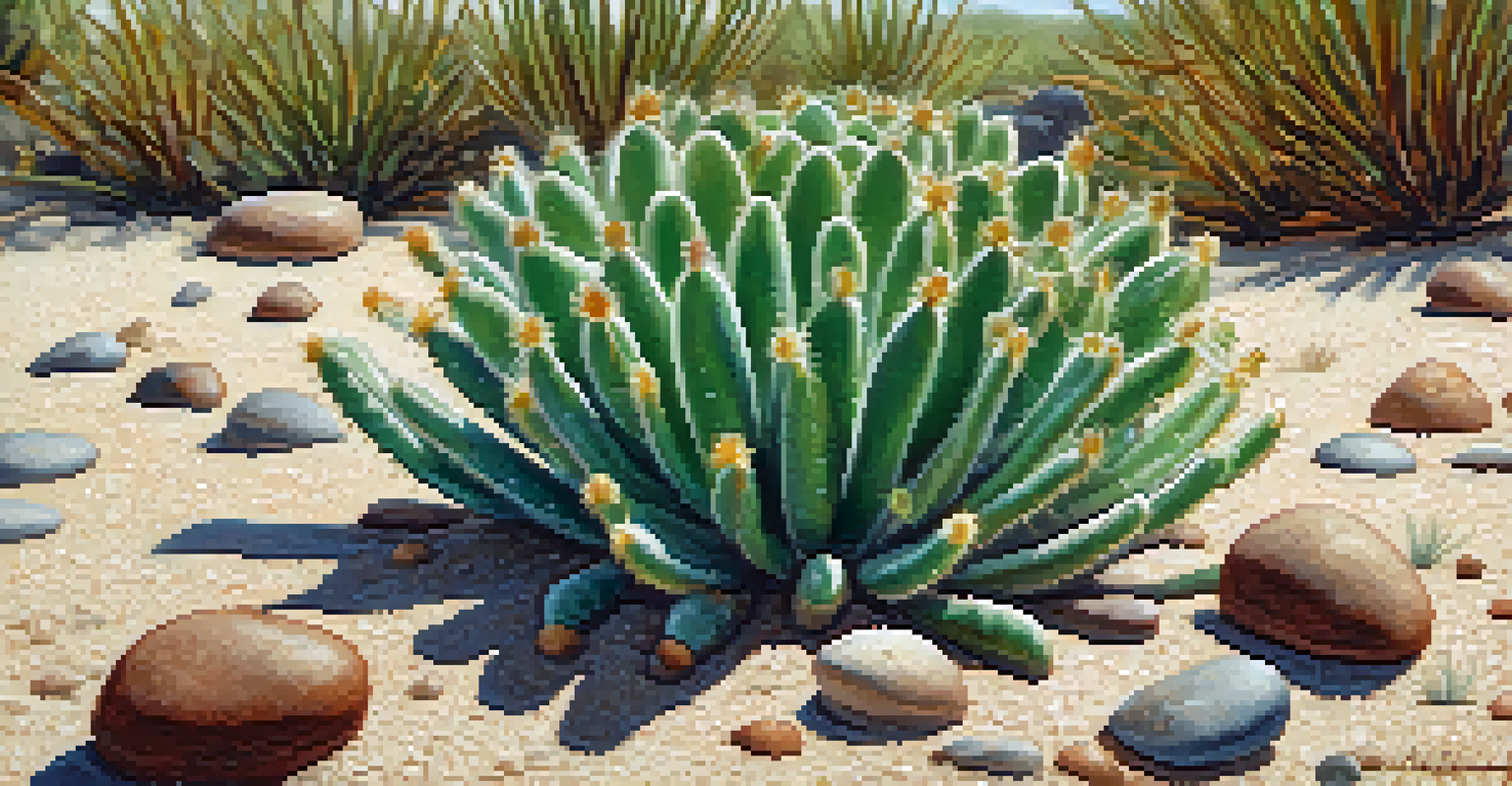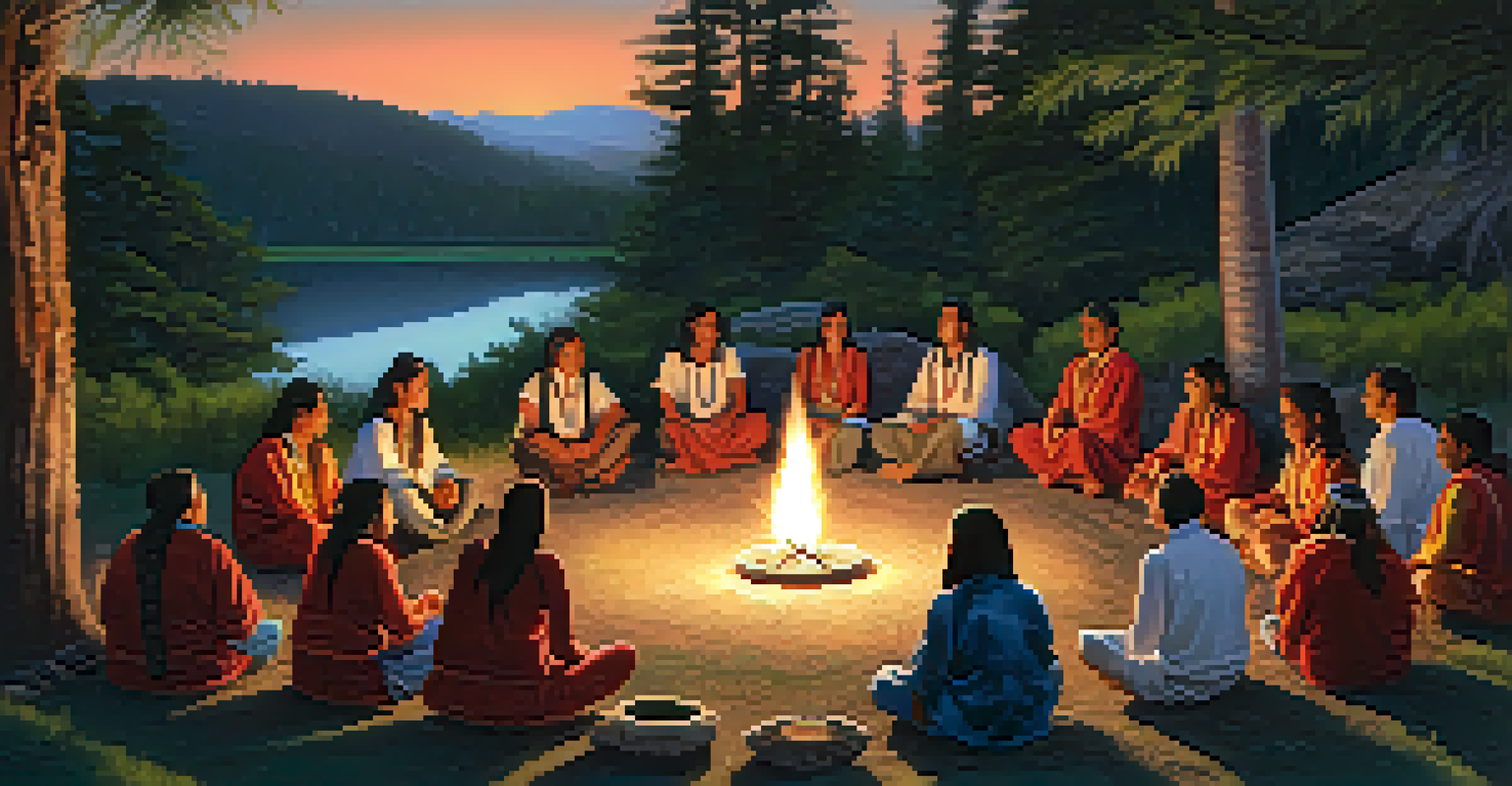Understanding Peyote: Significance in Indigenous Vision Quests

What is Peyote and Its Historical Context?
Peyote is a small, spineless cactus native to northern Mexico and the southwestern United States. It contains mescaline, a psychoactive compound that has been used for thousands of years by Indigenous peoples for spiritual and medicinal purposes. Understanding the historical context of peyote helps us appreciate its significance in various cultural practices.
The cactus is not just a plant; it is a bridge between the physical and spiritual worlds.
For many Indigenous groups, peyote is more than just a plant; it represents a vital connection to their ancestors and the natural world. Its use in rituals and ceremonies can be traced back to pre-Columbian times, highlighting its longstanding importance. This history shapes the way peyote is perceived and utilized today.
In contemporary society, the use of peyote often raises questions about cultural appropriation and respect for Indigenous traditions. It's essential to approach this topic with sensitivity, recognizing that peyote holds profound spiritual meaning for those who have used it for generations.
The Role of Peyote in Vision Quests
Vision quests are spiritual journeys undertaken by individuals seeking personal guidance or clarity. In many Indigenous cultures, peyote plays a crucial role in these quests, serving as a tool for introspection and connection to the divine. By consuming peyote, participants often report experiencing vivid visions and deep insights.

The experience of a vision quest can vary greatly from person to person. Some may find answers to pressing questions, while others might gain a renewed sense of purpose or direction. The shared experience of peyote among participants can also foster a sense of community and support, enhancing the journey's overall impact.
Cultural Significance of Peyote
Peyote holds deep spiritual and cultural importance for Indigenous communities, symbolizing healing and communal identity.
It's important to note that a vision quest is not merely about the consumption of peyote; it's a holistic experience that often includes fasting, solitude, and prayer. This combination of elements creates a sacred space for individuals to explore their inner selves and connect with the spiritual world.
Cultural Significance of Peyote in Indigenous Communities
Peyote is deeply embedded in the cultural practices and beliefs of many Indigenous communities, particularly among tribes such as the Huichol and the Native American Church. It is often seen as a gift from the Creator, symbolizing healing and enlightenment. This cultural significance extends beyond individual use, influencing community rituals and gatherings.
To me, peyote is a way of life, a connection to the spirit world that has been honored for generations.
In ceremonies, peyote is typically consumed in a communal setting, reinforcing social bonds and shared spiritual experiences. The act of coming together to partake in peyote rituals strengthens cultural identity and continuity, allowing traditions to be passed down through generations. It serves as a reminder of the importance of community in spiritual practices.
Moreover, the cultural significance of peyote has led to legal and political movements advocating for the rights of Indigenous peoples to use it in their ceremonies. These efforts highlight the ongoing struggle for cultural preservation and recognition in a rapidly changing world.
The Spiritual Benefits of Peyote Use
Many who participate in peyote ceremonies report experiencing profound spiritual benefits. These can include feelings of connection with nature, a greater understanding of life's purpose, and healing from personal trauma. Such experiences often lead to a deeper appreciation for the interconnectedness of all living things.
The spiritual journey facilitated by peyote can also encourage individuals to confront their fears and insecurities. As participants delve into their inner landscapes, they often emerge with newfound clarity and resilience. This transformative aspect is one reason why peyote remains a vital tool in many Indigenous spiritual practices.
Modern Challenges to Peyote Use
The use of peyote faces threats from overharvesting, habitat loss, and cultural appropriation, demanding sustainable practices.
However, it's essential to approach the use of peyote with respect and intention. The spiritual benefits are best realized within a structured ceremony led by experienced guides who understand the plant's significance and effects. This safeguards the integrity of the experience and honors the traditions that surround it.
Modern Challenges Facing Peyote Use
Despite its cultural significance, the use of peyote faces numerous challenges in modern society. Overharvesting, habitat loss, and legal restrictions threaten the availability of this sacred cactus. As demand increases, it becomes crucial to consider sustainable practices that respect both the plant and the Indigenous cultures that rely on it.
Additionally, cultural appropriation poses a significant concern. As more people become aware of peyote, there is a risk that its use may be stripped of its cultural context and reduced to a recreational activity. This can undermine the spiritual significance that peyote holds for Indigenous communities, leading to a disconnect between the plant and its traditional uses.
Advocacy and education play essential roles in addressing these challenges. By promoting awareness of the cultural and ecological aspects of peyote, we can help protect its future and honor the traditions of those who have revered it for centuries.
Legal Status of Peyote in North America
The legal status of peyote varies significantly across North America, influenced by historical, cultural, and political factors. In the United States, peyote use is legal for members of the Native American Church as part of their religious practices. This legal protection highlights the recognition of Indigenous spiritual rights, but it also raises questions about access for other groups.
In contrast, peyote is classified as a controlled substance in many places, limiting its use outside Indigenous communities. This legal framework can create tension between the desire to engage with peyote spiritually and the restrictions imposed by law. Understanding these legal nuances is crucial for anyone interested in the topic.
Legal Status of Peyote in North America
Peyote's legal status varies, with protections for Indigenous use, while restrictions limit access for others.
As discussions around drug policy and Indigenous rights continue to evolve, the future of peyote's legal status remains uncertain. Advocates argue for greater protections and recognition of Indigenous practices while navigating the complexities of modern legal systems.
The Future of Peyote and Indigenous Practices
Looking ahead, the future of peyote and its role in Indigenous practices will likely depend on a combination of advocacy, education, and sustainable practices. As awareness of the plant's significance grows, there is potential for a renewed appreciation for its cultural and spiritual value. This could lead to greater efforts to protect and preserve peyote habitats.
Moreover, fostering respectful dialogue between Indigenous communities and non-Indigenous individuals can help bridge gaps in understanding. By sharing knowledge and experiences, we can cultivate a deeper respect for the traditions surrounding peyote and support Indigenous rights in the face of ongoing challenges.

Ultimately, the future of peyote is intertwined with the resilience of Indigenous cultures and their commitment to preserving their sacred traditions. By honoring and respecting these practices, we contribute to a more inclusive understanding of spirituality and the natural world.